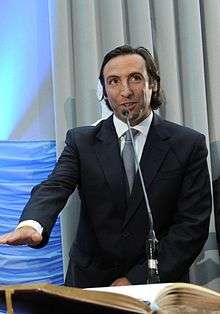Hernán Lorenzino
Hernán Gaspar Lorenzino (born March 5, 1972) is an Argentine lawyer and public policy maker. He was appointed Minister of Economy of Argentina by President Cristina Kirchner in 2011.
Hernán Lorenzino | |
|---|---|
 | |
| Minister of Economy of Argentina | |
| In office December 10, 2011 – November 18, 2013 | |
| President | Cristina Fernández de Kirchner |
| Preceded by | Amado Boudou |
| Succeeded by | Axel Kicillof |
| Secretary of Finance | |
| In office April 25, 2008 – December 10, 2011 | |
| President | Cristina Fernández de Kirchner |
| Preceded by | Hugo Secondini |
| Succeeded by | Adrián Cosentino |
| Personal details | |
| Born | March 5, 1972 La Plata, Argentina |
| Nationality | |
| Alma mater | National University of La Plata Torcuato di Tella University |
Life and times
Lorenzino was born in La Plata.[1] His family moved to Puerto Madryn, Chubut Province, in 1974, and Lorenzino was raised in the coastal Patagonia city. He met his future wife there, and together they enrolled at the National University of La Plata, where Lorenzino earned a Law degree and a master's degree in public finance;[1] he later earned a master's degree in Economics at Torcuato di Tella University.[2]
He was appointed Provincial Director of Funding Policy and Public Credit for the Province of Buenos Aires by Governor Felipe Solá in 2004, during which tenure he managed the redemption of the remaining Patacón bonds issued as complementary currency by Governor Carlos Ruckauf during the depths of the 2001 crisis.[3]
Following the end of Solá's administration in 2007, Lorenzino was appointed Financial Representative for Argentina in Washington, D.C.[1] The resignation of Economy Minister Martín Lousteau amid the 2008 Argentine government conflict with the agricultural sector in April, led to Lorenzino's appointment as Secretary of Finance for the new Economy Minister, the more conciliatory Carlos Rafael Fernández.[4] Lorenzino managed the second phase of the Argentine debt restructuring in this capacity;[5] its first phase had been initiated in 2005 by Economy Minister Roberto Lavagna, and had resulted in the renegotiation of two-thirds of the US$82 billion in sovereign bonds defaulted in 2001.[6] The second phase, involving the renegotiation of US$18 billion in bonds retained by holdouts from the 2005 exchange, was completed in June 2010. Holders of two-thirds of this latter tranche accepted the offer prepared by Lorenzino, and the proportion of bonds rescued from default thus rose to over 92%.[6]
Lorenzino also served in La graN maKro, a center-left economic and social policy think tank closely allied with Kirchnerism.[2] Enjoying a good working relationship with Economy Minister Amado Boudou, Lorenzino was nominated to replace him when the latter was elected Vice President of Argentina in President Cristina Kirchner's landslide, 2011 reelection. Lorenzino was, moreover, the most pragmatic major official in Boudou's team with regards to the international bond market and the Paris Club of creditors,[3] and the Minister-designate subsequently announced that debt restructuring would be acquire a greater policy relevance during his tenure.[7]
An April 2013 interview by Greek journalist Eleni Varvitsioti resulted in a stir when Lorenzino refused to answer a question regarding Argentine inflation; unbeknownst to him, the microphones were left on and recorded him saying me quiero ir ("I want to leave").[8] He then departed, leaving the interview unfinished, baffling both the local[9][10][11] and the international press.[12]
Lorenzino's tenure was marked by ongoing efforts to counter vulture fund lawsuits to obtain payment at face value on nearly USD1.5 billion of bonds bought for pennies on the dollar.[13] The Argentine offer prepared by Lorenzino, based on his successful 2010 restructuring, would give the largest of the vulture funds, Caymans-based NML Capital Limited, a 284% return; NML had filed injunctions in U.S. courts to attach future payments to other bondholders by way of forcing Argentina to settle and thus obtain returns of up to 1380%.[14][15]
Cristina Kirchner appointed Axel Kicillof as the new minister of economy on November 18, 2013. Lorenzino was sent in a task force to negotiate the Argentine debt restructuring.[16]
References
- "Designan a Lorenzino como Ministro de Economía". Ministerio de Economía. Archived from the original on 2011-12-16.
- "Perfil del ministro de Economía: Hernán Lorenzino". InfoBae.
- "Club de París e inflación, en el horizonte inmediato de Lorenzino". El Cronista Comercial.
- "El nuevo ministro de economía definió un equipo de continuidad". Mdz.
- "Argentina Debt Swap Architect Lorenzino to Lead Country's Economy Ministry". Bloomberg. December 6, 2011.
- "Hernán Lorenzino, un reestructurador de deuda que llega a ministro de Economía". La Nación.
- "Lorenzino: "Reestructurar la deuda es importante"". La Nación.
- "Lorenzino: La pregunta sobre la inflacion que descoloco a Hernan Lorenzino". La Nacion. Archived from the original on 2016-01-18. Retrieved 2013-04-25.
- "La pregunta sobre la inflación que descolocó a Hernán Lorenzino". La Nación. 25 April 2013.
- "Lorenzino protagonizó un bochorno en la TV griega: le preguntaron por la inflación y se escapó". La Nación. 25 April 2013.
- "'Me quiero ir', dijo Lorenzino y cortó una entrevista para no hablar de inflación". La Gaceta. 25 April 2013.
- Brian Winter (25 April 2013). "Argentina minister ducks inflation question, causes stir". Reuters.
- Arthur Phillips and Jake Johnston (April 2, 2013). "Argentina vs. the Vultures: What You Need to Know". CEPR.
- "Argentina offers to pay debts with cash & bonds". Yahoo News. March 30, 2013.
- "Banks Fear Court Ruling in Argentina Bond Debt". New York Times. February 25, 2013.
- Cristina Fernandez reshuffles cabinet and names new economic team
